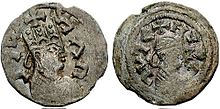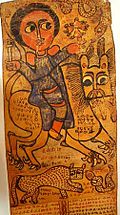Kaleb of Axum
| Kaleb of Axum ካሌብ Ἐλεσβαᾶς τῆς Ἀξωμιτῆς | |
|---|---|
 Coin of the Axumite king Kaleb | |
| King of Axum | |
| Reign | 514–542[1][2] |
| Predecessor | Ousas |
| Successor | Alla Amidas or Gebre Meskel |
| Born | Axum, Kingdom of Axum |
| Issue | Israel[1][3] Gebre Meskel[1][3] Possibly Gebre Krestos (Gebru)[3] |
King Kaleb: Saint Elesbaan | |
|---|---|
Roman Catholic Church | |
| Feast |
|
Kaleb (
Name
At Aksum, in inscription RIE 191, his name is rendered in unvocalized Gə‘əz as KLB ’L ’ṢBḤ WLD TZN (Kaleb ʾElla ʾAṣbeḥa, son of Tazena). In vocalized Gə‘əz, it is ካሌብ እለ አጽብሐ (Kaleb ʾƎllä ʾÄṣbəḥä).
Kaleb, a name derived from the Biblical character Caleb, was his given name. On both his coins and inscriptions he left at Axum, as well as Ethiopian hagiographical sources and king lists, he refers to himself as the son of Tazena.[9]
Life
Procopius, John of Ephesus, and other contemporary historians recount Kaleb's invasion of Yemen around 520, against the Himyarite king Yūsuf As'ar Yath'ar, known as Dhu Nuwas, a Jewish convert who was persecuting the Christian community of Najran. After much fighting, Kaleb's soldiers eventually routed Yusuf's forces and killed the king, allowing Kaleb to appoint Sumyafa Ashwa, a native Christian (named Esimiphaios by Procopius), as his viceroy of Himyar.
As a result of his protection of the Christians, Kaleb is known as Saint Elesbaan after the sixteenth-century Cardinal Caesar Baronius added him to his edition of the Roman Martyrology despite his being a Miaphysite.[10][11][12]
Aksumite control of Arabia Felix continued until c. 525 when Sumyafa Ashwa was deposed by Abraha, who made himself king. Procopius states that Kaleb made several unsuccessful attempts to recover his overseas territory; however, his successor later negotiated a peace with Abraha, where Abraha acknowledged the Axumite king's authority and paid tribute.[13] Stuart Munro-Hay opines that by this expedition Axum overextended itself, and this final intervention across the Red Sea, "was Aksum's swan-song as a great power in the region."[14]
It is also apparent that his reign was marked by a major integration of the Agaw tribes of what are today the districts of Wag and Lasta into his own kingdom. Cosmas Indicopleustes provides an important documentary confirmation for this. He makes a reference to the "governor of Agau", who was entrusted by Kaleb with the protection of the long-distance caravan routes from the south. According to Taddesse Tamrat, Kaleb's governor of Agau probably has his seat of government in the area of Lasta, which later serve as the center of the Zagwe dynasty.[15]
A historical record survives of a meeting between the Byzantine ambassador and historian Nonnosus and Kaleb in the year 530.[16]
Ethiopian tradition states that Kaleb eventually abdicated his throne, gave his crown to the Church of the Holy Sepulchre at Jerusalem, and retired to a monastery.[17] Later historians who recount the events of King Kaleb's reign include ibn Hisham, ibn Ishaq, and al-Tabari. Taddesse Tamrat records a tradition he heard from an aged priest in Lalibela:
Kaleb was a man of
Gebre Mesqel Lalibela had later established his centre. The relevance of this tradition for us is the mere association of the name of Kaleb with the evangelization of this interior province of Aksum.[18]
Besides several inscriptions bearing his name,
Issue and successors
A combination of literary, numismatical and epigraphical sources mention three sons of Kaleb named Gebre Meskel, Israel and Gebre Krestos, who all reigned as kings after him.
Sources give contradictory accounts of the events following the end of the reign of Kaleb. One source stated that
According to the Kebra Nagast Gebre Meskel was the youngest son of Kaleb and succeeded him to the throne after Kaleb retired to a monastery.[26]
See also
Notes
References
- ^ a b c Budge, E. A. Wallis (1928). A History of Ethiopia: Nubia and Abyssinia (Volume 1). London: Methuen & Co. p. 261.
- ISBN 0-7864-2562-8.
- ^ a b c d e f g h Sellassie, Sergew Hable (1972). Ancient and Medieval Ethiopian History to 1270. Addis Ababa. p. 159.
{{cite book}}: CS1 maint: location missing publisher (link) - ^ Blessed Elezboi, Emperor of Ethiopia. HOLY TRINITY RUSSIAN ORTHODOX CHURCH (A parish of the Patriarchate of Moscow).
- ^ Blessed Elesbaan the King of Ethiopia. OCA - Feasts and Saints.
- ^ Synaxarium. Ginbot 20 (May 28). Ethiopian Orthodox Tewahedo Debre Meheret St. Michael Church. Retrieved: 2012-10-30.
- ^ Synaxarium: The Book of the Saints of The Ethiopian Orthodox Tewahedo Church. Transl. of Sir E.A. Wallis Budge. Printed by the Ethiopian Orthodox Tewahedo Debre Meheret St. Michael Church, Garland, TX USA. p. 764.
- ^ The Roman Martyrology. Transl. by the Archbishop of Baltimore. Last Edition, According to the Copy Printed at Rome in 1914. Revised Edition, with the Imprimatur of His Eminence Cardinal Gibbons. Baltimore: John Murphy Company, 1916. p. 331.
- ^ S. C. Munro-Hay, Aksum: An African Civilization of Late Antiquity (Edinburgh: University Press, 1991), p. 84.
- ISBN 978-0-8146-2386-2.
- OCLC 6081480.
St. Elesbaan was an Aksumite king of Ethiopia who recovered the royal power in Himyar (Yemen) after the massacre of the Martyrs of Najran.
- ISBN 978-0-87973-373-5.
- ^ Procopius, De Bellis, i.20.8
- ^ Munro-Hay, Aksum, p. 88.
- ^ Taddesse Tamrat, Church and State in Ethiopia (Oxford: Clarendon Press, 1972), p.50
- ^ Bowersock, G.W, The Throne of Adulis: Red Sea Wars on the Eve of Islam (2013), p. 109
- ^ Munro-Hay, Aksum, pp. 88f.
- ^ Taddesse Tamrat, Church and State in Ethiopia (Oxford: Clarendon Press, 1972), p. 26 n. 1
- ^ The translation of one inscription, written in Geʽez, appears with discussion in George Wynn Brereton Huntingford, The Historical Geography of Ethiopia (London: The British Academy, 1989), pp. 63-65.
- ^ Munro-Hay, Aksum, p. 91.
- ^ The report of the 1973 excavation of these structures was published in Stuart Munro-Hay, Excavations at Aksum (London: British Institute in Eastern Africa, 1989), pp. 42ff.
- ^ Budge, E. A. (1928a). A History of Ethiopia: Nubia and Abyssinia (Volume I). London: Methuen & Co. pp. 211–212.
- ^ Páez, Pedro (2008). Isabel Boavida; Hervé Pennec; Manuel João Ramos (eds.). História da Etiópia (in Portuguese). Assirio & Alvim. pp. 104–105, 107–108.
- ^ Sellassie, Sergew Hable (1972). Ancient and Medieval Ethiopian History to 1270. Addis Ababa. pp. 159–160.
{{cite book}}: CS1 maint: location missing publisher (link) - ^ a b c d e Sellassie, Sergew Hable (1972). Ancient and Medieval Ethiopian History to 1270. Addis Ababa. p. 160.
{{cite book}}: CS1 maint: location missing publisher (link) - ^ Budge, E. A. (1922). Kebra Nagast: The Queen of Sheba and Her Only Son Menyelek. pp. 226–227.
External links
- Blessed Elesbaan the King of Ethiopia Eastern Orthodox synaxarion
- Elesbaan, king, hermit, and saint of Ethiopia entry from the Dictionary of Christian Biography and Literature to the End of the Sixth Century A.D., by Henry Wace
- Catholic Online: Saint Elesbaan
- Katolsk.no: Elesbaan

